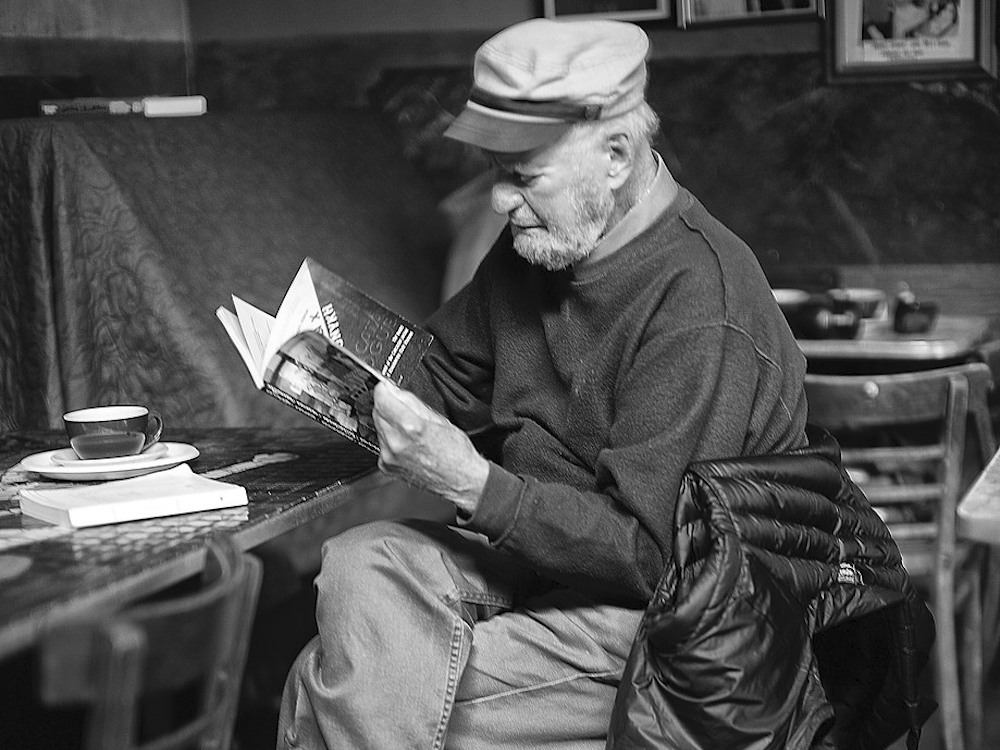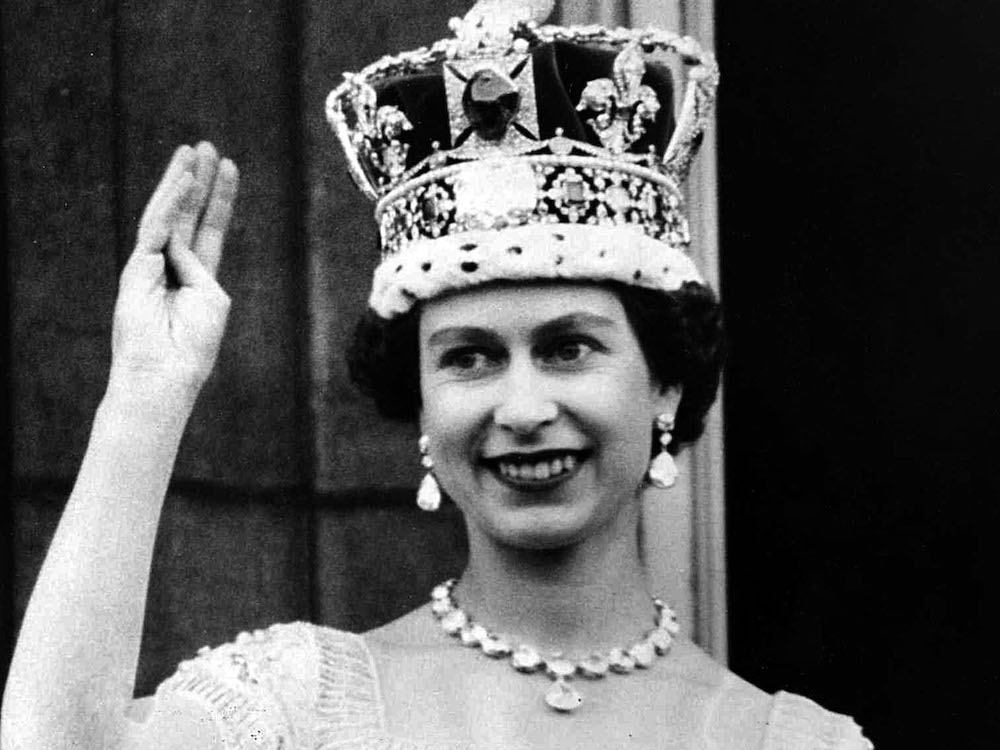
Lawrence Ferlinghetti at Caffe Trieste, 2012. Photo: Christopher Michel (CC BY-SA 4.0 (https://ift.tt/2E6q6du). Via Wikimedia Commons.
I have always loved November. I don’t know if that’s because I was born in it or because it’s when fall becomes the cruelest version of itself. The air bites; the final leaves fall to the ground. Either way, the month is tailor-made for nostalgia. At times like these, I often turn to the first poet I ever loved, Lawrence Ferlinghetti. In high school, I memorized “The Pennycandystore beyond the El” and recited it to myself daily, a strange sort of mantra. At the time, I thought myself the girl in the poem, a heaving form full of tragedy and potential. But now, I see I am the cat, strolling among the sweets, unhurried and unbothered. I don’t know if I’ll ever be the man. Or maybe that’s all I’ve ever been, sitting in the “semigloom,” “in love with unreality.” —Noor Qasim
I picked up Bernadine Evaristo’s Girl, Woman, Other one evening earlier this week thinking I’d get fifty pages in and save the rest for the weekend. Hours later, I realized it was 1 A.M. and that I needed to force myself to go to bed for work the next morning. Evaristo’s Booker Prize–winning novel is a compulsively readable exploration of the lives of twelve characters in contemporary Britain, the majority of them black and female. Much of the book converges around The Last Amazon of Dahomey, a play by Amma—whose chapter opens the novel—that is set to premiere at the National Theatre. Each chapter takes the voice of a different character, many of them connected to one another through blood or friendship, and as Evaristo moves closer to the premiere of the play, she explores questions of race, gender, sexuality, immigration, and what it means to be British. There’s something truly pleasurable to watching a virtuoso at work, and Evaristo’s ability to switch between voices, between places, and between moods brings to mind an extraordinary conductor and her orchestra. —Rhian Sasseen
“There should be a hundred words in our language for all the ways a black boy can lie awake at night,” Saeed Jones writes in his memoir, How We Fight for Our Lives. Jones, an acclaimed poet and journalist with a talent for expressing the ineffable, may be uniquely capable of giving us these words. In this slim book, Jones describes his experience growing up as a queer black boy in Texas and his struggle to carve out space for himself within a family and country that were often hostile. The story is told through a series of cinematic vignettes that trace a course through Jones’s tumultuous young adulthood. In one, we see an adolescent Jones fighting his devoutly Christian grandmother. In another, we see his early forays into sexuality—some tender, some treacherous. Throughout, Jones weaves an unflinching examination of race and sexuality, grappling with a violent national mythology and reflecting on events such as the AIDS crisis and the murder of Matthew Shepard. In all, it is an uncommonly generous book, one that refuses simple explanations. When describing a harrowing scene in which a lover turns violent, for instance, Jones recalls looking up at his attacker, and says, “I didn’t see a gay basher; I saw a man who thought he was fighting for his life.” Jones’s work—which falls naturally into the legacy of Toni Morrison and Roxane Gay—engages with the physical body as a complicated site of experience and identity, capable of both lust and violence, vulnerability and power. Many passages in the book warrant underlining. But one of the most powerful, for me, comes about halfway through the story, when Jones—lying in bed in a stranger’s home—realizes “that my body could be a passport or a key … a brick thrown through a sleeping house’s window.” Jones’s gradual discovery of his own power, both sexual and creative, is one of the book’s most exciting and ultimately moving arcs. —Cornelia Channing
One Friday at the start of November, I left work early and threaded my way uptown through throngs of tourists to see “Artistic License: Six Takes on the Guggenheim Collection” (on view through January 12, 2020). For this show, six artists affiliated with the Guggenheim have selected themes for each of the rotunda’s ramps and curated displays from the museum’s holdings. The result is a provocative, interwoven exhibition that feels both contemporary and relevant. It begins with selections made by the artist Cai Guo-Qiang: seventy-five mostly unknown small paintings and sketches hung together on the main wall, including some by Picasso, Franz Kline, and Rothko. Next—my favorite section—is Paul Chan’s, a collection of works that together challenge the classical motif of water in art, inviting visitors in with cerulean carpeting and a demand to “reflect on how pleasure renews us.” The ramp begins with a blue Mondrian and ends with a late de Kooning, with much to see in between (including some wonderful works by Laurie Simmons). The other sections—curated by Richard Prince, Julie Mehretu, Carrie Mae Weems, and Jenny Holzer—are all just as exciting, but I won’t spoil the surprise. —Camille Jacobson
Let me begin by saying I am not a monarchist, but I do love The Crown. This week saw the long-awaited release of the Netflix show’s third season, in which we reencounter Elizabeth II in middle age, in 1964. In the first two seasons, Claire Foy plays the younger queen; in Season 3, Olivia Colman takes up the hair curlers and three-quarter sleeves (the titular headgear makes only rare appearances on screen, though its weight, shown to us memorably in a coronation episode, hangs over everything). Colman lends Elizabeth an irresistible, anxious frankness that feels just right at this point in the story. Having gone through three prime ministers, a very rough marital patch, the discovery of her uncle’s Nazi sympathies, and a nearly catastrophic rift with her sister, among other trials, she’s a bit world-wearier than her younger self yet still vulnerable to the pressures of her role. She frowns unambiguously and often, as she is regularly told things she does not want to hear. Occasionally, she flashes the kind of earnest smile that expresses not pleasure but an attempt at interpersonal diplomacy—you know, a “Princess Margaret, please go with the flow and do not embarrass us even though as a sister I acknowledge the wrongness of your always having to live in my shadow” smile. That’s the irresolvable conflict at the heart of The Crown—Elizabeth as individual who never wanted to be queen and is aware of the multilevel injustices of the system, versus Elizabeth as monarch who relies very much on protocol and the recommendations of various male advisers. The basic appeal of the series is as a window onto the human beings inside one of the world’s most revered and reviled institutions. From a different angle, it’s about a woman without “traditional” (i.e., male) leadership qualities who has been handcuffed to a symbolic leadership role and forced to deal with the resentment of, it sometimes seems, everyone around her. Either way, it’s fascinating. —Jane Breakell

Queen Elizabeth II at her coronation, 1953. Photo: National Science and Media Museum, via Wikimedia Commons.
from The Paris Review https://ift.tt/2KN89WJ

Comments
Post a Comment